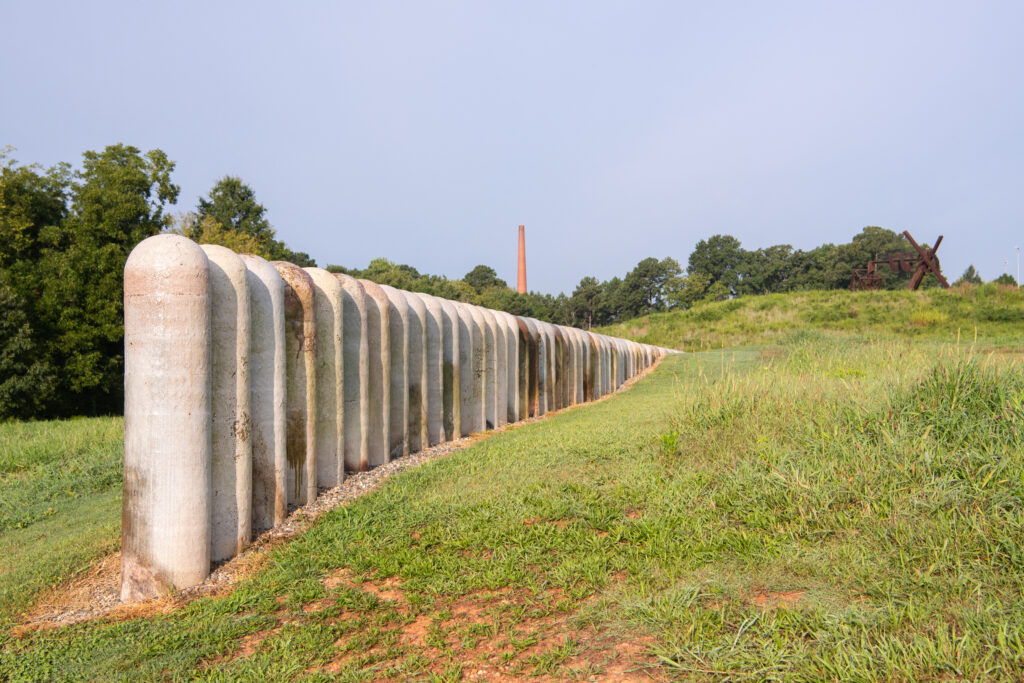Installation 1–183 (work of art)
Artwork Info
Key Ideas
- Despite the number in the title, this installation is actually made up of 178 ceramic columns. The other five are symbolic.
- The columns appear to look the same, but each one has a unique pattern of wear on its surface. The columns vary in height from several inches to over six feet tall.
- Each column was made from locally mined Piedmont clay. The artist used a combination of hand building and a pottery wheel to create each column. He then fired each column individually in a wood kiln.
- Artist Daniel Johnston is from Seagrove, North Carolina. This small town has a long history of pottery making. Johnston continues to live and work in Seagrove, where he has his own pottery studio.
- Johnston designed this site-specific work to play against the rolling landscape of the Museum Park. He created the illusion of a long line of identical columns that recede into the hillside.
- Johnston’s work combines pottery-making styles and techniques from different cultures.
Learn More
Installation 1–183 is a site-specific work by pottery and ceramics artist Daniel Johnston. It consists of 178 wood-fired clay columns. The other five columns are symbolic. Johnston built each column by hand, using locally mined Piedmont clay as his medium. He fired each individual piece in a wood kiln, in his studio in Seagrove, North Carolina.
Seagrove became a home for potters in the 18th century, due to its abundance of clay for pottery and trees for firewood. Johnston immersed himself in Seagrove’s pottery and ceramics culture as a teenager. He worked as an apprentice to local potters, who taught him more about the craft and helped him refine his skills. He also spent time in England and Thailand, where he learned traditional methods of creating and firing pottery.
The columns that make up Installation 1–183 range in height from approximately seven inches to seven feet. The tops of each column form a level line to highlight the dips and rises of the rolling hillside. This means the shortest columns are on the highest points, and the tallest columns are on the lowest points. Each column is a different height, yet they work together to create a straight line.
Johnston created each of the columns using a combination of hand building and a thrown pottery wheel. As the wheel spun, he built height by laying coils of wet clay in the shape of a column. To match the curves of the landscape and create a level line of columns, Johnston had to calculate what the height of each column needed to be, based on where it would rest on the hill. He also had to factor in how much a wet column would shrink when it dried, and how much it would shrink even more when he fired it in his kiln.
Due to the size and scale of this installation, Johnston had to build a custom kiln in which he could fire the largest columns. When it was time to install this work in the Museum Park, Johnston camped on the Museum grounds and worked overnight to complete it.
I use local clay to make all of my pots. The refining process is labor intensive but the simplicity of mining clay and transforming it into useful and beautiful objects is greatly rewarding and fulfilling on many levels.
Daniel Johnston
Additional Resources
Resources for Teachers
- Read the artist’s biography.
- Read a review of a book about the artist’s pottery.
- Watch a video of an installation of the artist’s work.
Resources for Students
- Read an article about the artist and his process.
- Watch a video of the artist at work.
- Watch a video of the artist explaining how to shape large pots.

